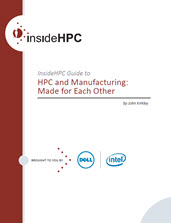
Bringing HPC to Manufacturing Large and Small
There are about 300,000 manufacturers in the United States, according to the National Center for Manufacturing Sciences (NCMS). Over 95% are characterized as small to medium sized manufacturers (SMMs) with less than 2,000 employees. Although small in size, when compared to global firms like General Electric, Ford and Procter & Gamble, the SMMs pack a lot of clout. NCMS says that they account for more than twice the total employment of all the Tier One manufacturers combined and generate about three quarters of the total global R&D output. In fact NCMS has coined a new term —“backbone manufacturers”— to identify this important segment of the economy. In its recently released Voice of the Customer (VOC) survey, NCMS notes that “Without the backbone, the biggest manufacturers simply couldn’t operate.” NCMS is one of many organizations and institutions attempting to bring high performance computing (HPC) to the backbone manufacturers — especially modeling, simulation and analysis (MS&A). Although HPC has made major inroads into the Tier One manufacturers, the technology has, with some notable exceptions, received a lukewarm reception from the backbone manufacturers.
Unsupervised machine learning is a more openended style of statistical learning. Instead of using labeled data sets, unsupervised learning is a set of statistical tools intended for applications where
there is only a set of feature variables measured across a number of observations. In this case, prediction is not the goal because the data set is unlabeled, i.e. there is no associated response variable that can supervise the analysis. Rather, the goal is to discover interesting things about the measurements on the feature variables. For example, you might find an informative way to visualize the data, or discover subgroups among the variables or the observations. One commonly used unsupervised learning technique is k-means clustering that allows for the discovery
of “clusters” of data points. Another technique called principal component analysis (PCA) is used for dimensionality reduction, i.e. reducing the number of feature variables while maintaining the
variation in the data, in order to simplify the data used in other learning algorithms, speed up processing, and reduce the required memory footprint.
All information that you supply is protected by our privacy policy. By submitting your information you agree to our Terms of Use.
* All fields required.




